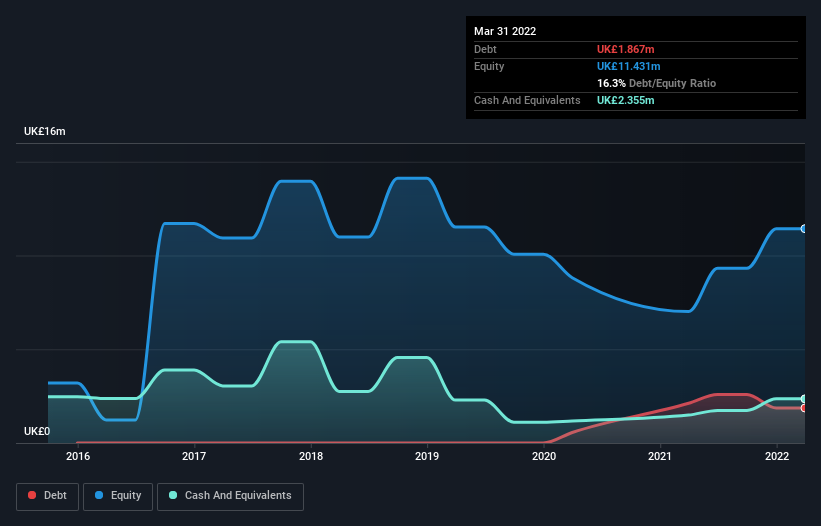Is CyanConnode Holdings (LON:CYAN) A Risky Investment?
Howard Marks put it nicely when he said that, rather than worrying about share price volatility, 'The possibility of permanent loss is the risk I worry about... and every practical investor I know worries about.' So it seems the smart money knows that debt - which is usually involved in bankruptcies - is a very important factor, when you assess how risky a company is. We can see that CyanConnode Holdings plc (LON:CYAN) does use debt in its business. But the real question is whether this debt is making the company risky.
Why Does Debt Bring Risk?
Debt and other liabilities become risky for a business when it cannot easily fulfill those obligations, either with free cash flow or by raising capital at an attractive price. If things get really bad, the lenders can take control of the business. However, a more common (but still painful) scenario is that it has to raise new equity capital at a low price, thus permanently diluting shareholders. Of course, debt can be an important tool in businesses, particularly capital heavy businesses. The first thing to do when considering how much debt a business uses is to look at its cash and debt together.
See our latest analysis for CyanConnode Holdings
What Is CyanConnode Holdings's Debt?
You can click the graphic below for the historical numbers, but it shows that CyanConnode Holdings had UK£1.87m of debt in March 2022, down from UK£2.12m, one year before. But it also has UK£2.36m in cash to offset that, meaning it has UK£488.0k net cash.
How Healthy Is CyanConnode Holdings' Balance Sheet?
The latest balance sheet data shows that CyanConnode Holdings had liabilities of UK£4.45m due within a year, and liabilities of UK£909.0k falling due after that. On the other hand, it had cash of UK£2.36m and UK£7.56m worth of receivables due within a year. So it can boast UK£4.55m more liquid assets than total liabilities.
This surplus suggests that CyanConnode Holdings has a conservative balance sheet, and could probably eliminate its debt without much difficulty. Succinctly put, CyanConnode Holdings boasts net cash, so it's fair to say it does not have a heavy debt load! There's no doubt that we learn most about debt from the balance sheet. But it is future earnings, more than anything, that will determine CyanConnode Holdings's ability to maintain a healthy balance sheet going forward. So if you're focused on the future you can check out this free report showing analyst profit forecasts.
Over 12 months, CyanConnode Holdings reported revenue of UK£9.6m, which is a gain of 49%, although it did not report any earnings before interest and tax. Shareholders probably have their fingers crossed that it can grow its way to profits.
So How Risky Is CyanConnode Holdings?
By their very nature companies that are losing money are more risky than those with a long history of profitability. And in the last year CyanConnode Holdings had an earnings before interest and tax (EBIT) loss, truth be told. Indeed, in that time it burnt through UK£3.4m of cash and made a loss of UK£871k. With only UK£488.0k on the balance sheet, it would appear that its going to need to raise capital again soon. CyanConnode Holdings's revenue growth shone bright over the last year, so it may well be in a position to turn a profit in due course. By investing before those profits, shareholders take on more risk in the hope of bigger rewards. When analysing debt levels, the balance sheet is the obvious place to start. But ultimately, every company can contain risks that exist outside of the balance sheet. We've identified 4 warning signs with CyanConnode Holdings , and understanding them should be part of your investment process.
Of course, if you're the type of investor who prefers buying stocks without the burden of debt, then don't hesitate to discover our exclusive list of net cash growth stocks, today.
Have feedback on this article? Concerned about the content? Get in touch with us directly. Alternatively, email editorial-team (at) simplywallst.com.
This article by Simply Wall St is general in nature. We provide commentary based on historical data and analyst forecasts only using an unbiased methodology and our articles are not intended to be financial advice. It does not constitute a recommendation to buy or sell any stock, and does not take account of your objectives, or your financial situation. We aim to bring you long-term focused analysis driven by fundamental data. Note that our analysis may not factor in the latest price-sensitive company announcements or qualitative material. Simply Wall St has no position in any stocks mentioned.
Join A Paid User Research Session
You’ll receive a US$30 Amazon Gift card for 1 hour of your time while helping us build better investing tools for the individual investors like yourself. Sign up here

 generic
generic 
